The content of the article
The common viper is a kind of poisonous snake, which can often be found not only in the forest-steppe zone, but even at the summer cottage, in a pond or on the porch of your own house. These reptiles belong to the family of Vipers and are considered a variety of snakes from the genus of the real viper.
The common viper is not afraid of low temperatures, so this species of snake can often be found in the high mountains and far northern regions. Its habitats stretch across the map from Western Europe to the Far East. The nature of the adder is very aggressive, often attacks a person, protecting its territory or offspring.
Fact! The common viper is often confused with the usual snake, which does not represent any danger to humans.
Snake Appearance
This reptile has an average body size. As a rule, the size of the common viper depends on its breeding sites. The largest representatives of this species live in the region in the North of Europe. In the Scandinavian lands, these snakes can grow up to 1 meter. In the north-west of Europe in England and in the north of France, these reptiles have a shorter body up to 80-85 cm. In other habitats of the adder, the common viper can have a body up to 55-60 cm in length. Usually the female viper is slightly larger than the male of this species. The weight of this reptile can be from 50 to 100 grams. The largest individuals can lead up to 180 g.
The head of the snake is large, has a flat shape, its surface is covered with small scales. On the head there are plates that perform the function of protecting the eyes, the crown and the front of the serpentine muzzle. The reptile's head is separated from the rest of the body by a barely perceptible neck. In the viper there are not very large eyes with over-eyed scales, the vertical pupil is clearly visible. Appearance gives the viper awesome look. In females, the eyes are much smaller, and in males - more. On the face you can see the nasal plate or nasal opening.The upper jaw of the snake is very mobile, endowed with two large poisonous fangs and several small teeth. The body of the viper goes into a small tail with a blunt end that resembles the outline of a comma.
Mother nature has generously endowed this species of snake with various colors and shades. In addition to the most typical gray color of the body in males and brown in females, there are other shades of vipers in the wild. The color of the body of reptiles may have a dark brown, black, copper-red, silver, beige-yellow or olive-brown shade. The surface of the body of these snakes often has natural patterns in the form of stripes, spots and zigzag patterns. Less commonly, these reptiles have a single color. However, against the background of a dark shade of the body, it is often impossible to consider a zigzag pattern. In the upper part of the reptile's head, dark marks in the form of a natural ornament are visible. On the sides of the head stretch dark stripes that move from the eyes to the corners of the snake's mouth.
Where does the adder live?
Typically, these reptiles choose for breeding the outskirts of swampy places, hiding in forest clearings, overgrown burned grass, live in glades among mixed and coniferous forests, moss-covered places, on the banks of rivers and ponds. The snake of this species has spread up to 3000 meters above sea level. As a rule, these vipers lead a sedentary lifestyle and do not like to move from their homes to more than a hundred meters. Only during the search for wintering, with the beginning of migrations in the spring or autumn period, can these snakes cross the river and creep up distances of up to five kilometers. Often, the adder can be found in the forest-park zone, in the basement in the country or in a rural house, in abandoned buildings, in the garden, in rural areas.
Lifestyle and behavior

By its nature, this reptile is inactive, moves slowly, has a calm character. It can be called a homebody.In summer, the snake likes to lie in the sun, and spends the whole day in a secluded place away from prying eyes. Often reptiles are looking for a warm place on heated rocks, under stumps or fallen trees, in a rocky crevice among the rocks.
If you carefully watch this snake, then you can note some characteristic features in the reptile's behavior. If the snake lies and relaxedly basks in the sun, then it moves the ribs apart, and the body becomes flat with a wave-like surface. However, if the reptile is on the watchman, then it becomes tense, the torso is stretched, and outwardly it resembles a tight compressed lump in the form of a spiral. If the enemy met on the path of a reptile, the snake with a quick movement, like a spring, lifts the upper part of the body. To scare the enemy, she inflates her body, hissing terrifyingly. This tight tangle crawls smoothly in the direction of the source of danger to self-defense.
To survive the winter, the vipers find shelter in the rodent burrows or crevices. They crawl under the ground to a depth of two meters. In such a shelter during the wintering period, the temperature can vary from 3 to 4 degrees Celsius.Very often several representatives of this family winter in such burrows to warm each other. If the spring comes early and the snow melts, the snakes can crawl to the surface to bask in the sun. If several dozen representatives of the species spend the winter in the mink, then a large wriggling ball appears on the surface.
The most active life cycle of a viper comes from March to April. The first to bask in the sun rays from the winter shelter are the males creeping out, and only when the air warms up above 24 ° C do the viper females crawl out of the hole. During the winter sleep period, up to 15% of adults and 40% of young individuals perish in nature.
The life span of this snake in the wild under favorable conditions can reach from 12 to 15 years. At the same time, in the serpentry and specialized terrariums, the adder can live for 20 to 30 years. The longevity of snakes in such conditions is explained by the fact that reptiles receive constant food, they are protected from the attacks of enemies, and the microclimate and timely medical assistance of veterinarians also favor.
The enemies
Despite its virulence, the viper has many potential enemies in the wild. The reptile can be a dinner for hedgehogs, boars, owls, eagles and other birds of prey. If the reptile met on the path of a man, then he most often tries to kill a snake for self-defense.
Nutrition
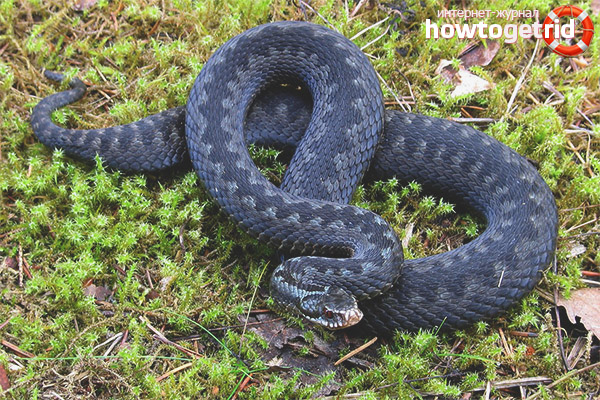
On the hunt, these reptiles creep out at nightfall. The diet of these snakes includes mice, frogs, and also feeds on lizards, newts, salamanders, hatched chicks and bird eggs. The menu of vipers depends on their habitat. Juveniles feed on worms, spiders and frogs. As they grow, after the viper’s body reaches 30 cm, the young snakes switch to a more adult diet. With the onset of cold weather, these reptiles fall into hibernation, which lasts from 150 to 180 days. But in the coldest northern latitudes, the hibernation of the viper can take up to nine months.
The venomousness of the common viper
Reptiles are believed to have virtually no hearing, so snakes do not leave their territory when a person appears. However, the entire viper body is very susceptible to various fluctuations.If a person steps on soft, for example, peaty soil, the reptile feels the movement of the earth with its whole body. When a person gets in the way of a viper, she considers him an enemy, and quickly attacks in order to defend herself. She triggers protective instincts, this explains the behavior of the snake during an attack on a person.
It is believed that the adder is not able to bite through the thick fabric of jeans or shoes. However, people still need to avoid the habitats of this venomous snake. If the adder is still attacked a person, then its bite is not considered fatal. The bitten man is soon getting better. However, the bite of this snake can be very painful and dangerous to health. After the bite, edema appears on the surface of the wound, then acute anemia occurs, the patient has dizziness, headache, severe weakness and progressive shock. The blood inside the vessels begins to collapse, changes occur in the body - in the tissues of the liver and kidneys. The victim must be taken to the hospital for medical care.
There are cases when a snake stricken by a bite cannot timely consult a doctor for help, therefore seasoned tourists recommend taking special serum with them on such dangerous hikes.In order to neutralize the poison of the viper, the patient should inject an anti-adder serum or its analogue under the skin. The required therapeutic dose is 150 AU. Before you enter the serum against the venom of the viper subcutaneously, the victim must take 1 or 2 tablets of the drug Prednisolone or any antihistamine, such as Suprastin or Tavegil. These medicines will help the patient cope with an allergic reaction in the body. If the victims do not have a “miraculous” serum with them, then it is necessary to pack the patient and constantly give him to drink plenty of water. Alcohol in such cases is prohibited to give. It is also not recommended to suck out poison from the wound, because a person may have invisible damage to the oral cavity. After that, you must immediately call an ambulance.
Video: common viper (Vipera berus)

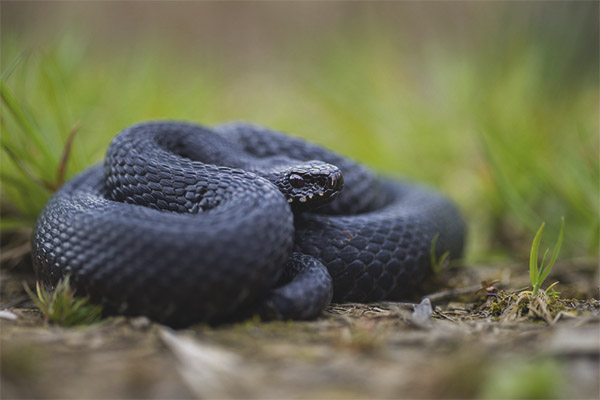

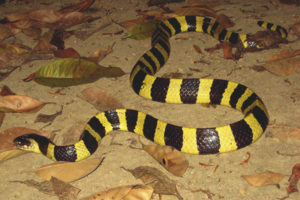

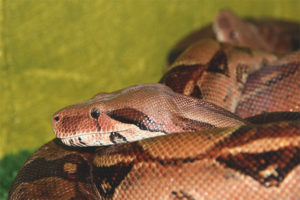
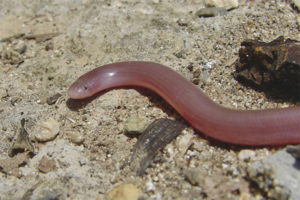
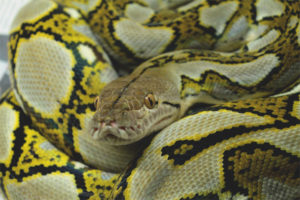
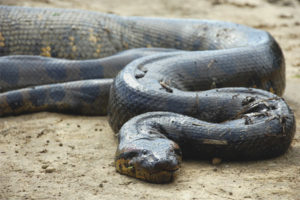
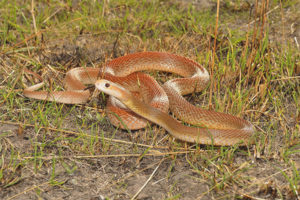
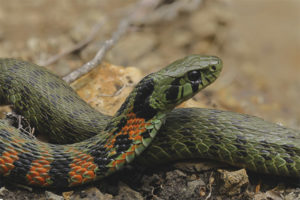
To send